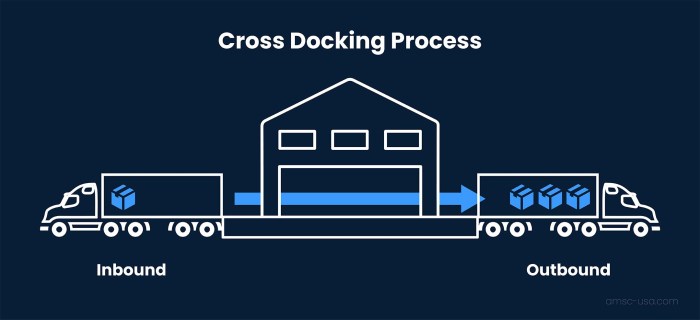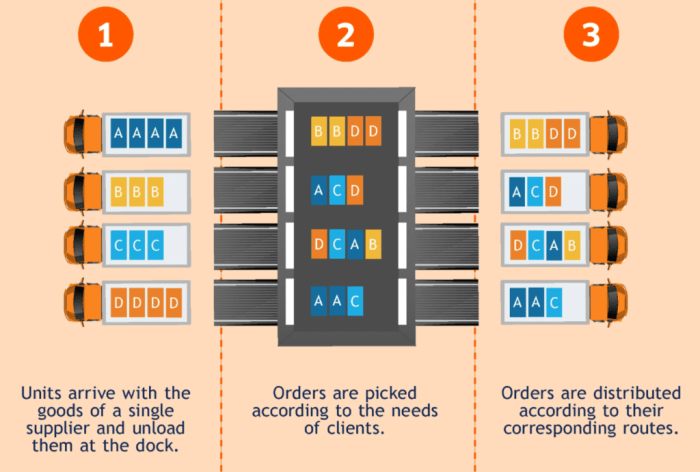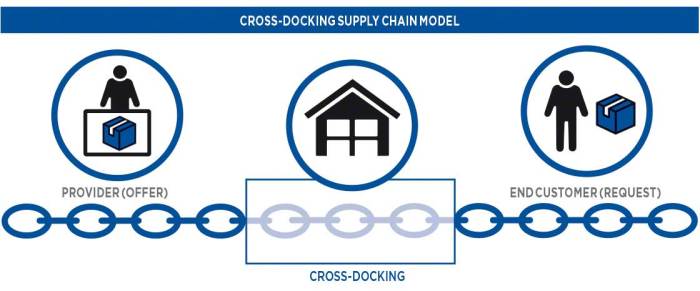Cross-docking is an operations and supply chain maneuver whereby goods are received and shipped out without being stored in a warehouse. This efficient and cost-effective practice offers numerous benefits to businesses, including reduced inventory holding costs, improved customer service, and increased supply chain agility.
Cross-docking can be classified into various types, such as inbound cross-docking, outbound cross-docking, and combination cross-docking, each with its unique characteristics and applications.
Introduction to Cross-Docking

Cross-docking is an operations and supply chain maneuver whereby inbound goods are received and directly shipped to outbound destinations without being stored in a warehouse. Its purpose is to improve efficiency, reduce costs, and enhance customer service by eliminating unnecessary handling and storage.Cross-docking
offers several benefits to businesses, including reduced inventory levels, increased warehouse space utilization, improved product flow, and faster delivery times. It also helps reduce transportation costs by consolidating shipments and minimizing the need for multiple deliveries.
Types of Cross-Docking
There are three main types of cross-docking:
- Inbound cross-docking:Goods are received from multiple suppliers and consolidated into shipments for specific customers.
- Outbound cross-docking:Goods are received from a single supplier and distributed to multiple customers.
- Combination cross-docking:A combination of inbound and outbound cross-docking, where goods are received from multiple suppliers and distributed to multiple customers.
Benefits of Cross-Docking

Cross-docking offers numerous benefits, including:
- Reduced inventory levels
- Increased warehouse space utilization
- Improved product flow
- Faster delivery times
- Reduced transportation costs
- Enhanced customer service
Challenges of Cross-Docking: Cross-docking Is An Operations And Supply Chain Maneuver Whereby
Cross-docking can present challenges, including:
- Coordination between suppliers and customers
- Inventory management
- Transportation logistics
- Warehouse design
- Technology integration
Best Practices for Cross-Docking

To successfully implement and manage cross-docking operations, it is important to follow industry best practices, such as:
- Establishing clear communication and coordination protocols
- Implementing an efficient inventory management system
- Optimizing transportation logistics
- Designing a warehouse that supports cross-docking operations
- Utilizing technology to streamline processes
Case Studies of Cross-Docking
Numerous successful cross-docking implementations have been documented across various industries. One notable example is Walmart’s distribution network, which leverages cross-docking to reduce inventory levels and improve product flow. Another example is Amazon’s fulfillment centers, which utilize a combination of cross-docking and other supply chain strategies to achieve fast and efficient delivery times.
Future Trends in Cross-Docking

The future of cross-docking is expected to be driven by emerging trends and innovations, such as:
- Increased automation
- Data analytics
- Collaborative technologies
- Sustainable practices
These trends will continue to shape the evolution of cross-docking and enhance its efficiency and effectiveness in supply chain management.
Detailed FAQs
What is the primary purpose of cross-docking?
Cross-docking aims to eliminate unnecessary storage and handling of goods, thereby reducing inventory holding costs and improving supply chain efficiency.
What are the key benefits of cross-docking?
Cross-docking offers several benefits, including reduced inventory costs, improved customer service through faster delivery times, increased warehouse space utilization, and enhanced supply chain agility.
What are the challenges associated with cross-docking?
Cross-docking can present challenges related to coordination between suppliers and customers, inventory management, transportation logistics, and the need for accurate and real-time information sharing.